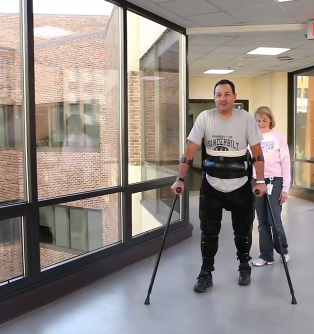02/25/2015

We are in an era of rapidly advancing science and technology, particularly in medicine. We also are witnessing unprecedented growth in data, IT and social communication. These changes are provoking synergistic combinations of healthcare and technology that we hope will advance and improve human health beyond what was fathomable only in science function.
Despite the promise, we must be wary of any crucial misrepresentation of medical advances. We see this in the endless commercials for pharmaceuticals often with deceptively rosy claims and dire warnings. (Honestly, I just want to watch my Thursday night shows.) This can lead us to be either overly skeptical or unduly optimistic about new technologies we see on the evening news or on the internet. How does one differentiate science from pseudoscience from science fiction? The answer is that we watch what we see on TV with interest, but we buy based on solid science.
Exoskeleton Ambulation Devices
Exoskeleton ambulation is one such area with tremendous promise that should be explored cautiously. The Holy Grail for most people in a wheelchair is to be able to walk again. People in a chair, short- or long-term, yearn to get back on their feet. But walking can mean many different things. Many who can walk without active movement in their legs (by using braces, crutches and swinging the legs through) choose not to due to stress on the arms, lack of efficiency or practicality, or because it does not replicate the reciprocal steps that are normal to them. Previous orthotics (i.e. braces) have for the most part splinted the legs to provide positioning or rigidity for weight bearing while remaining functioning muscles do the work of movement. Wheelchairs have become more nimble for efficient movement, but have obvious limitations in inaccessible environments and do not allow the standing eye-to-eye contact people desire.
“Exoskeleton” gait devices are braces with complex computer-assisted power devices to allow robotic movement back and forth (see examples in our video). The term exoskeleton refers to the fact that these braces are worn outside the body to provide rigidity (compared to the real skeleton inside). These devices were initially conceived for military use to enhance able-bodied soldiers’ ability to lift and carry heavy equipment. This goal is still not fully realized due to the complexity of the tasks.
However, makers of exoskeleton devices have found great interest among the spinal cord injury community. Headlines from the lay press of “paralyzed people walking again” certainly can lead one to the false conclusion that paralysis has been cured or bypassed. Though some companies are trying to combine exoskeletons with external electrical stimulation to allow muscle movement to propel gait, most current models are passive; that is, the brace moves the legs, not the other way around.
Expected Benefits and Current Drawbacks
This is exciting new technology, and one can easily consider the potential functional advantages and medical benefits of being upright. Current exoskeleton devices, used in rehabilitative environments and not in the community, can enable someone to get up from a seated to a standing position, and move forward at a slow speed. Some predict that such devices may become so lightweight you could put them on as clothes, though the materials required for such a benefit do not yet exist in usable form.
Exoskeletons can propel a user forward at about 1 mile per hour in controlled environments, compared with a normal comfortable gait speed of approximately 3 miles per hour. For the most part, users require a gait device (e.g. cane or crutch) and an assistant for safety purposes, and the device must be worn all day to permit spontaneous movement. The current cost of these devices can exceed $100,000 and may be significantly higher when you consider cost of the device, training, assistance and repairs. If the replacement frequency of other DME can be used as a guide, these may need to be replaced every 3-5 years.
More Study Needed
None of the limitations mentioned here are meant to dampen the excitement that there may be a robotic alternative to being wheelchair-bound. But behind the hype of a short evening news segment, is the need to be scientific. Most studies so far cover a very small number of carefully selected participants. One must be very careful to look at the characteristics of the participants to make sure functional claims did not include activities the participants could already do. In addition, a number of potential medical benefits, such as less skin breakdowns, better cardio-respiratory status and less osteopenia, have been proffered to counterbalance or justify the price, but these have not yet been evaluated by randomized controlled studies. Any such studies would also need to compare the exoskeleton to already existing technology of wheelchairs, cushions and standing frames.
The healthcare and research community must continue development to answer a number of important questions. What are good financial outcomes? Will this shorten rehabilitation hospital stays? Can this help patients return to work? Will the devices lower overall healthcare and personal care assistant costs? This all must sound dreadfully tedious compared to the headlines, but the scientific process and economic realities demand we fully understand the benefits and risks to make wise investment decisions.
The desire to stand and walk is natural. Who wouldn’t want to regain that ability? The great thing about effective technological advances is they have always become faster, smaller, more advanced and more affordable over time. The hope of the paralyzed population is certainly there. But beyond the hype, we look forward to continued rehabilitation research to help clarify the evidence-based benefits and identify the best technology available.